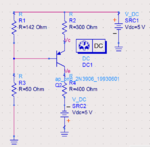muheeb16
Member level 3
I have always found it very easy to design with dual supplies.This circuit uploaded by me is operating in active region because Vec=3V.Mostly in such circuits very negligible base current flows (don't know why).I find this very strange because the base current controls the collector current.On the contrary if I replace the negative battery (on the bottom right) with ground very large base current starts flowing.I can not understand why?

